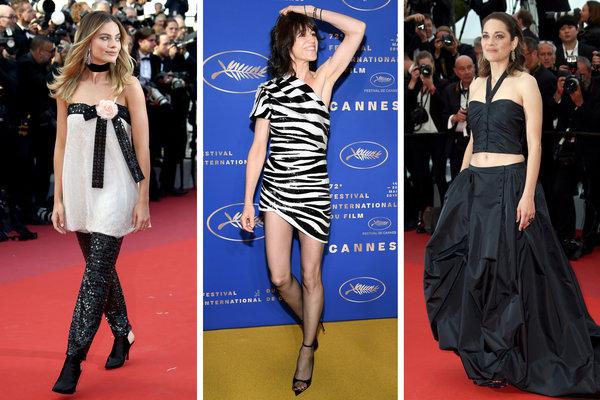If Elle Fanning doesn’t come away from the most recent Cannes Film Festival, which began May 14 and ends Saturday, with a next-level fashion ambassador contract, something has gone seriously wrong with the celebrity style industrial complex.
Ms. Fanning, after all, has been something of the star of the show, swanning down the red carpet in liquid gold Gucci, cape trailing behind, embroidered pansy at her waist; posing on the sweeping steps to the Palais des Festivals et des Congrès in voluminous floral Valentino, and vamping in wasp-waist Dior, an enormous hat shadowing her face, at the premiere of “Once Upon a Time in Hollywood.”
Whether you liked what she wore or not, and I didn’t love all of it, there was no denying she liked it, and was having a great time playing dress-up.
In the process, she (and her stylist, Samantha McMillen) reminded us all that while the red carpet is a business, it’s also about fashion — in its most celebratory incarnation.
That’s essentially why we, the audience, like to ogle these particular parades. Yes, we also like to see how ridiculous some people look and make snide comments, but essentially there should be something happy and fairy tale about getting to be all fancy for a night, however an individual chooses to define fancy. It’s a subconscious pull to the story of Cinderella and the glass slipper.
In the wake of what seems like an increasingly calculated Met Gala and boringly serious Oscars (except for the men), this defining quality is starting to seem lost. The deals have taken the fun out of dressing, which is ironic, because fun is why we watched in the first place, and the watching is why the deals began to be made. This year, Cannes brought it back.
It’s about time.

From left, Margot Robbie, Charlotte Gainsbourg and Marion Cotillard.CreditFar Left and Far Right: Joel C. Ryan/Invision, vai Joel C. Ryan/Invision/AP; Center: Pascal Le Segretain/Getty Images
So there was Charlotte Gainsbourg, in short, zebra-striped Saint Laurent, thrown on with the insouciance of a T-shirt: Yeah, I’m dressed up, but whatever! It’s sunny. Here was Helen Mirren, going old-school glam in pink and gold Elie Saab — and matching pink hair. There was Dakota Fanning in an utterly stripped-down Armani ball gown; here was Julianne Moore in a slither of silver Givenchy armor, capped by a fluttering rose cape.
There were a lot of pants — Léa Seydoux in Vuitton, Margot Robbie in sequined Chanel pants and a filigree white Princess and the Pea tunic — and cropped tops: Marion Cotillard, in a low-slung Chanel skirt and halter top.
A few days later, Ms. Cotillard appeared in another cropped top, this time with shorts, which also proved something of a Cannes evening-wear thing, sometimes paired with a ball gown, sometimes worn as the equivalent of a bedazzled playsuit. It was one of the weirder (and less successful) trends to emerge from the festival, but was also a reflection of the fact there’s something more relaxed and risk-taking about the whole carpet-by-the-Croisette.
There were still some over-the-top look-at-me absurdities; explosions of woman-eating tulle and trains so long the wearer looked like the Little Engine That Could, tugging them along. And still some desperate plays for paparazzi attention via the reduction of clothing to little flesh-covering scraps. Sometimes the experimentation went too far: Ms. Fanning reportedly fainted because of a too-tight Prada corset dress.
But overall, and perhaps because of the rising decibel level of women’s voices at Cannes, their use of the festival as a forum to assert equality and independence, there was a sense that they were asserting independence of wardrobe, too; defining it for themselves.
The result was a notably good fashion moment. Maybe the best of the year so far.
“The Met is a costume ball, and there’s so much riding on the Oscars, but Cannes is where you can establish personality,” said the stylist Karla Welch, pointing out that film festivals offer multiple appearance opportunities: not just at a premier, but during daytime photo calls as well as the diamond-studded parties thrown by brands like Vanity Fair and Chopard. That means multiple outfit opportunities (jury members like Ms. Fanning need 10 to 20 looks, according to Ms. Welch), which puts the focus less on a single choice than the aggregate impression.
In addition, she noted, though the jewelry arrangements were out in force, “I don’t think there are a lot of clothing deals at Cannes” (the names already locked down by various brands, like Ms. Robbie and Chanel, the Vuitton ganglet, which includes Selena Gomez and Ms. Seydoux, excepted). There’s money at play but it’s mostly attached to films and distribution, rather than, say, dresses. Which is as it should be.
And though Cannes, and the festivals that follow, are where brands spot the talent they want to sign; where they start getting wind of who may be the Next Big Red Carpet Thing when awards season dawns later in the year; which movies and which stars are getting the most buzz. At the moment, it’s mostly still potential.
That’s not to say the attention magnets are actually buying the clothes (they are borrowing them, or swapping pictures and press for clothes). But they aren’t necessarily being paid to wear the outfits either; they, and their stylists, are picking them.
And you know what: It makes for better dresses. Something to think about, as the year rolls inexorably on, and the carpets roll out.







